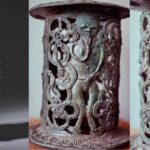Recent research unveils intriguing insights into the historical migration of the Akweya people and their potential first sojourn in the Ogoja region. Akweya, who currently inhabit the Akpa district of Idoma land, offer a unique glimpse into the complexity of modern Idoma ethnicity.
 While they are politically integrated, the Akweya are linguistically distinct and possess a culture that draws from both Idoma and Akweya traditions. Their claims of an Apa origin are under scrutiny, with evidence suggesting that they migrated from Apa to the Ogoja area, north of the Cross River, before settling in their current home.
While they are politically integrated, the Akweya are linguistically distinct and possess a culture that draws from both Idoma and Akweya traditions. Their claims of an Apa origin are under scrutiny, with evidence suggesting that they migrated from Apa to the Ogoja area, north of the Cross River, before settling in their current home.
Oral traditions in Otobi and Akwete recount that the Akweya, also known as Akpa, left Apa due to a war, possibly involving the Beri-beri (Kanuri) from the direction of Bornu. This war had both territorial and religious dimensions, as it aimed to acquire land and impose Islamic practices on the Akweya.
While some confusion exists in these traditions, they often merge historical events like the Fulani holy war waged against the Benue in the early 19th century with earlier conflicts. Fortunately, genealogical records offer a cross-check for such events.
Oral accounts widely agree that the Akweyas initially fled south to Ogoja, and there is evidence of a group called the Iyache (Yache) in that region who speak a dialect of the same language. It’s presumed that these two groups were once a single entity, but the Iyache chose to settle in Ogoja while the Akweya continued their journey.
The Akweya faced challenges as they moved west and northward through Ijigbam, encountering resistance from the Igede and Ufia. They eventually found their present land, which was then inhabited by the Edumoga kindred. Akweya‘s interactions with various neighbouring groups have left lasting impressions on their rituals, beliefs, and attitudes, as well as vice versa.
Over the centuries, the Akweya have maintained close contact with various Idoma kindred groups. The 18th and early 19th centuries were marked by turbulence, with many groups vying for land. However, the middle and late 19th centuries saw consolidation for the Akweya, and relations with neighbours have been relatively peaceful since.
The Akweya consider the Oglewu people their truest friends among Idoma groups, and intermarriage has resulted in stranger lineages from Oglewu settling in the Akpa district. These interactions have influenced Akweya traditions and their approach to kingship.
Conversely, the Akweya have brought beliefs and institutions from the Cross River area into Idoma groups, which they adopted during their sojourn in Ogoja.
It’s essential to note that not all Akweya oral traditions are straightforward; many contain elements of myth and should be viewed allegorically rather than taken as literal accounts. These stories often serve as metaphors, reflecting the Akweya people’s perspective on their history.
The research aligns with Armstrong’s belief that the Akweya‘s migration path corresponds with the Apa-Ogoja Idomaland route. While some have suggested that the Akpa-Akweya group represents a fusion of the original inhabitants with Idoma migrants, there is limited evidence to support this theory within Akweya oral traditions.
This research adds depth to our understanding of the Akweya people’s journey and their interactions with neighbouring groups during their migration. It sheds light on the complex history of the Idoma ethnicity and their connections with various communities along the way.

Extracted from the archives of late Chief Akpallah Okenyodo’s research on history.
Follow the AkweyaTV channel on WhatsApp: https://whatsapp.com/channel/0029Va7m7dvJuyA7h5XMc22i

















